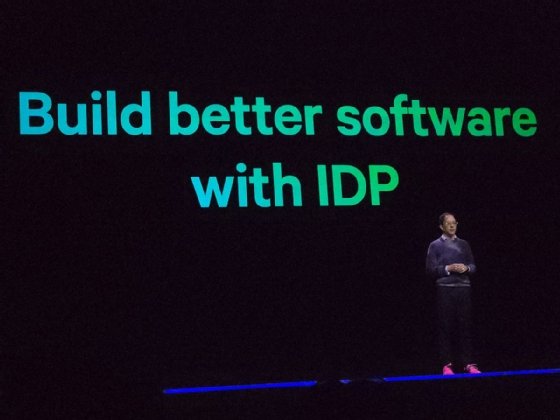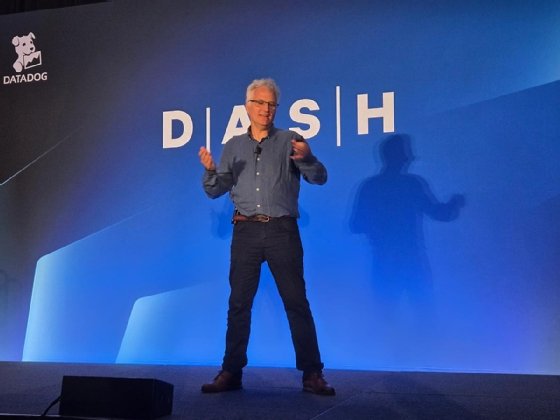
your123 - stock.adobe.com
DevOps pros eye Datadog developer portal for ITSM
DataDog advances onto Atlassian and ServiceNow's turf with a self-service developer portal that draws on real-time data about the observed state of IT resources.
NEW YORK -- Datadog took a significant step into fresh IT automation territory this week by shipping an internal developer portal within its growing set of ITSM tools.
At least for now, the new Datadog internal developer portal remains distinct from internal developer platforms. Both abbreviated IDP, an internal developer portal focuses on centralized service discovery for developers, while internal developer platforms offer more extensive, often customized "golden paths" developers use to ship software to production.
Presenters at Datadog DASH 2025 this week emphasized that Datadog's developer portal can work alongside existing tools, including the Cloud Native Computing Foundation's Backstage. In its initial release, the Datadog developer portal is focused on offering developers self-service access to troubleshooting, updating and creating IT infrastructure and services within the Datadog Service Management IT service management (ITSM) suite, which also includes the Datadog On-Call incident management product introduced last year. With its first release, Datadog's internal developer portal includes a software catalog, self-service actions for developers built on predefined templates and scorecards that measure whether IT services conform to enterprise policies.
While the new developer portal doesn't yet include golden paths for software deployment, it can already invoke processes in Datadog's Workflow Automation orchestration tool and third-party CI/CD tools to set up or block software deployments, according to Michael Whetten, vice president of product management, during a pre-conference interview with Informa TechTarget.
"Right now, it's more [focused on] visibility and governance," Whetten said. "We'll probably get deeper into declaring and shipping new services pretty soon."
Datadog's internal developer portal is unlikely to unseat broader workflow automation, ITSM and developer platforms by vendors such as Atlassian and ServiceNow at large organizations, Whetten said, but DevOps and incident response teams within enterprises might use the portal to collaborate. Companies still making the transition to cloud-native infrastructure that are otherwise coordinating efforts using spreadsheets and manual processes will also find it appealing, he said.
At the same time, Whetten touted its internal developer portal as a more user-friendly and potentially more accurate alternative to configuration management databases (CMDBs) that are traditionally the purview of larger ITSM vendors.
"This is built off of observed state and not declared state," he said. "A lot of the traditional CMDBs were hard to keep up to date even for customers who are using things like Backstage -- the complaint is that it's high maintenance, and a lot of that goes away since we're actually looking at what is deployed, and then we can attach it back to other systems of record."

Datadog developer portal displaces Backstage at Nexthink
For one observability-focused customer of Datadog, early access to the developer portal over the last six months prompted a move away from a Backstage pilot project.
"We decided to switch because it was using the exact same files, the exact same formats, with no change to what we did before with Datadog," said Pascal Gandilhon, head of observability for Nexthink, Inc., makers of digital employee experience management software in Lausanne, Switzerland, in an interview with Informa TechTarget this week. "We can have everything on the same portal in the same place, not a different tool, again -- in the DevOps world, tool proliferation is a huge problem."
Nexthink first signed a purchase agreement with Datadog in late 2023, moving away from another observability vendor that Gandilhon declined to name. He said Nexthink made the switch primarily because Datadog supported custom metrics, which were a lower-cost alternative to the existing vendor's metrics built on pre-indexed logs, and because developers at the company had experience with Datadog.
Improving continuous delivery practices for newer cloud-native microservices apps is among the next items on Nexthink's docket, where the developer portal could also play a role, Gandilhon said. The company also uses GitHub Actions and Microsoft Azure, but Datadog "would be the natural choice" for managing those workflows at Nexthink, he said.
"We are already using the advanced features of observability in Datadog APM [application performance management], so we have everything related to latency, dependencies, traces already there," Gandilhon said. "Maybe a company using just the metrics and logs might consider another tool, but if you are already deeply involved with the APM and all the features around the APM, it's a no-brainer to use the Datadog portal."

Enterprises play IDP mix-and-match
Datadog's ITSM tools did not replace another vendor at Nexthink, but a manually maintained and ad hoc approach to incident management based on static documents that kept the company in "survival mode," according to a breakout session presentation by Gandilhon.
For other session attendees who already work with ITSM tools such as Atlassian's Jira Service Management and Incident.io, adoption of Datadog's developer portal won't be as straightforward as a simple replacement. But the idea of linking ITSM directly to observability data does hold some appeal.
"There is some bridge building to be done between these tools," said Eric Swanson, site reliability engineer at data management company DBT Labs in Philadelphia, in an interview at DASH following Gandilhon's session. "It might just be shoring up your metadata, tagging and attributes in Jira that could help you connect and get more value out of the on-call portion of Datadog."
For another DASH 2025 presenter with an established Backstage deployment, Datadog's developer portal won't displace the highly customized system an internal platform team has already built, but it might appeal to smaller companies for a similar purpose.
"The size of the team comes into play -- if you have a couple of dev teams and 50 services or something like that, it might not make sense to build and run the whole thing," said Mark Avery, software engineer at event management software maker Cvent, headquartered in Tysons, Va., during a Q&A at the end of a DASH 2025 panel session. "You get a lot of nice things with Datadog, as a reliable, truthful source of real data, rather than some kind of user-inputted data."
For one industry analyst in attendance at DASH 2025, the deciding factor for companies considering Datadog's developer portal won't ultimately be company size but how tech-focused they are, and how crucial it is for them to respond to incidents in real time.
"If it's a more engineering-focused organization, deeper down into the weeds, they're probably going to be leaning into the Datadog side and say, 'ServiceNow is going to manage the workloads after our process workflows,'" said Carlos Casanova, an analyst at Forrester Research. "But if you're at a higher level, you're probably going to be looking at it from the ServiceNow perspective, saying, 'We get all of our telemetry alerts and events from Datadog, and it can manage some of those things, but we want to manage it at a higher level of business understanding.'"
Leaning too far into the high-level approach might mean companies are too late to respond to urgent incidents, while erring on the side of real-time alerts could mean overreacting to low-impact issues, Casanova said.
"It's going to get tricky, but I think it's going to probably play out in terms of an organization's technology maturity," he said -- at least, for the time being.
"All of these platform organizations are already overlapping, and right now they seem to be working and playing nice together, but at some point, markets will push one to try to squeeze the others out," Casanova said.
Beth Pariseau, a senior news writer for Informa TechTarget, is an award-winning veteran of IT journalism covering DevOps. Have a tip? Email her or reach out @PariseauTT.





